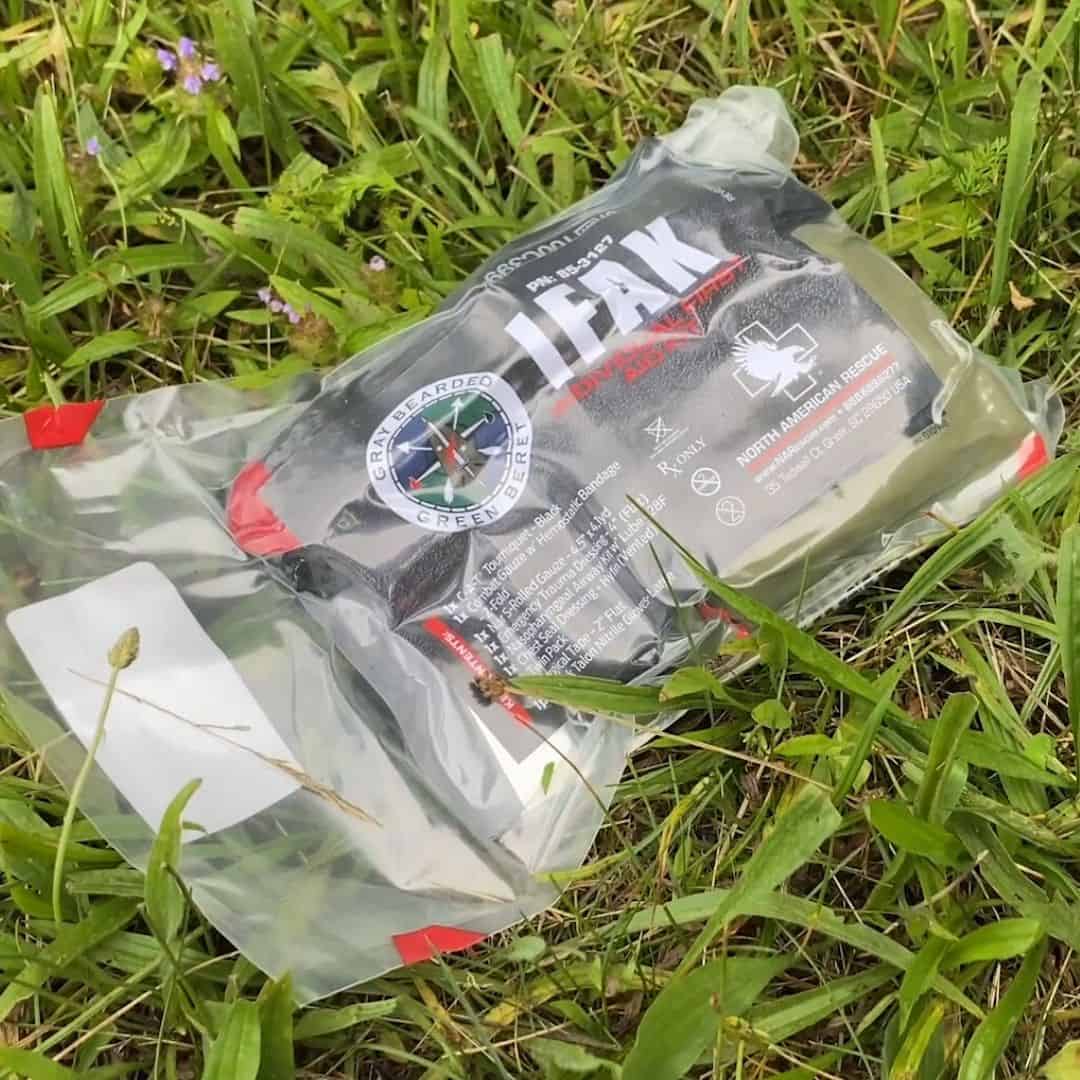First Aid Kit
When developing a kit for Wilderness First Aid, it is important to look at what the most common injuries are in the wild and pack resources that allow you to manage those things. The most common injuries in the backcountry are:
4 B’s of Wilderness Medicine
- Bleeding
- Breaks, Sprains, and Strains
- Burns and Blisters
- Bites and Stings
A wilderness first aid kit typically uses a lot of your other gear to improvise medical gear for common wilderness injuries. That is okay to do as a supplement to having proper gear for what you are trying to address. Again, we don’t improvise on purpose, and some wounds are very time sensitive so we don’t want to improvise at all if we don’t have to.
BLEEDING
Bleeding can be the most time-sensitive, so while you can improvise a tourniquet with other items from your kit, this is one you really shouldn’t. You need to carry a real tourniquet to use, and have a second tourniquet to back that up if it fails to stop the bleed. If the bleed is severe enough that you need to use it, you may not have time to improvise it.
The GB2 IFAK was designed with this in mind. The Combat Application Tourniquet (CAT) that comes standard inside the vacuum-sealed package is meant to be your backup tourniquet. Your primary tourniquet should be readily accessible and staged where it can be reached in a hurry and not sealed inside a package inside the IFAK.
Often, a wound isn’t quite bad enough to need a tourniquet, or it is severe enough but the wound is in a junctional area where you cannot use a tourniquet. In either case, you will need Wound Packing Gauze to pack the wound and an Emergency Trauma Dressing to put on a pressure dressing to stop the bleed. Both of these items come standard in the GB2 IFAK.
 Other things to consider are hypovolemic shock from blood loss and hypothermia. Both of these can be addressed with your shelter and fire, but if you don’t have either of those already in place when the injury happens, a simple, lightweight Emergency Survival Wrap can help.
Other things to consider are hypovolemic shock from blood loss and hypothermia. Both of these can be addressed with your shelter and fire, but if you don’t have either of those already in place when the injury happens, a simple, lightweight Emergency Survival Wrap can help.We recommend add-ons including: Trauma Shears to expose the wound in a hurry if needed, a CAT to use as your primary tourniquet, and an Emergency Survival Wrap to help manage shock/hypothermia.
The GB2 IFAK Pouch was designed specifically for use with this system. The IFAK fits inside the case along with the Emergency Survival Wrap. It has a special holder for the Trauma Shears inside as well that keeps them secure but allows easy access. There are also external tourniquet keepers on the outside of the pouch that allow you to choose where best to store your primary CAT for easy access.
BREAKS, SPRAINS, AND STRAINS
Breaks, Sprains, and Strains are typically less time sensitive with the exception of a compound fracture where you have bleeding to deal with before dealing with the break. It is worth carrying at least one dedicated SAM Splint and a couple of Elastic Wrap Bandages to manage at least one injury, while multiple injuries may require you to improvise splints if you don’t have enough dedicated resources with you. In addition, you will want to have at least two Triangular Bandages so that you can properly immobilize a shoulder or arm injury.
 BURNS AND BLISTERS
BURNS AND BLISTERS
Typically for burns in the wilderness, you will see smaller surface area burns. For example, a small burn on the palm of the hand from grabbing a hot water bottle from the fire. You should carry at least one Burn Dressing and a Dry Sterile Burn Cravat to handle this. The Burn Dressing can also be used for soothing and protecting blisters.
 BITES AND STINGS
BITES AND STINGS
For bites and stings, be familiar with what snakes and insects are in your area and take precautions. Venomous snake bites are rare, but they can be deadly if you cannot get help quick enough.
Contrary to popular belief, whatever folk remedy you heard isn’t going to do anything for you. It will probably do more harm than good. Time is of the essence, and all these do is delay getting yourself to the hospital which is what you actually need.

THERE IS NO SUCH THING AS A "SNAKEBITE KIT” THAT ACTUALLY WORKS.
Your “snakebite kit” is your car keys and cell phone and getting to an emergency room as quickly as possible.
For insect stings, they are typically not dangerous unless you are allergic, so if that is you, make sure you have what your doctor recommends in your kit when you go out. In addition, if you have any other pre-existing medical conditions, you should pack your prescription meds.
Remember that even though you may not be trained in how to use all of these items on others, you may be the one that is injured. The resources you carry are to be used on you primarily, and someone coming to your aid may have the skill to use them if you have the resources available for them to use.
Recommended First Aid Kit:
- GB2 IFAK
- IFAK Add-Ons
- IFAK Pouch
- SAM Splint
- Elastic Wrap Bandages (2)
- Triangular Bandages (2+)
- Burn Dressing
- Dry Sterile Burn Cravat
- Car Keys and Cell Phone
- Bee Sting Kit (If allergic)
Join us for a Live Course or Workshop here. For more info check out my downloadable content here or books and PDFs here.
Be Prepared First. I hope to see you around our campfire soon!
-Joshua

